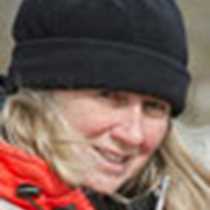Pléneau Island & Port Lockroy, Antarctica
We see the world in a different light, each and every one of us. Where we have come from, where we have been, our experiences color our perceptions. Here we are now, a community, united in our passion. It has called to us, this distant land, the land of ice and snow. We come, cradling a deep rooted curiosity. How did those explorers of the heroic past feel when their feet lit upon these shores? Whalers and sealers were here too. Were they so involved in their profession that they could not see the towering mountain peaks running with glacial rivers?
The black and white print of the morning scene showed shades of subdued gray except for splashes of blue and pink. The tall peninsular peaks slept within a misty blanket and yet the ice pouring from their flanks glowed as lit from within. The freshly fractured faces were brushed with delicate blue. Petermann Island, as we passed, flashed its rosy apron of red snow algae, trampled in places by dirty penguin feet. Pléneau Island, rounded by ice from the past, murmured with the hum of gentle gentoo voices. We silently sat upon the salt and pepper colored ridges savoring the scene of giant icebergs parked below. Soon Zodiacs ferried us between these monolithic sculptures, each different from the other.
Cradled within the arms of Wiencke Island is found a perfect harbor. Today it is easy to read its stories in remnants left behind by waves of vessels seeking shelter here. Whale bones litter the shore at Jougla Point. Unafraid, a Weddell seal slept comfortably in their presence while a leopard seal snored from an ice floe, oblivious to thundering glacial calvings. Concrete anchor blocks, formerly for radio antennae hid fluffy gentoo chicks waddling about on feet too big for their bodies. Painted black and orange, the restored British research hut on tiny Goudier Island welcomed our curious minds and our generous contributions to their postal station.
As evening comes, we synthesize our memories of the day. Each’s journal entry will be different although the location was the same. Let's peak inside one couple’s mind.
The Only Land Carnivore in Antarctica!
We are two Naturalists from the Galápagos Islands. It is our first time in the cold waters of the Southern Continent, and as you can imagine, every single day has been full of nature's surprises. Today we disembarked, on the West coast of the Antarctic Peninsula on Pléneau Island. We hiked carefully and took pleasure in and around hundreds of Gentoo penguins (known as Juanito penguins in Spanish), unaware of our presence, just as they might have been unaware of French explorer Charcot a century ago.
We sat down on the gray granodioritic rocks and enjoyed the moment. Aura Banda, my companion, pointed out a beautifully hidden, shy but green cover, cloistering between large cracks of the rocks. Mosses and lichens were there, sheltered from the cold wind. Then, she spied the largest terrestrial animal in the whole continent (4mm), a midge, Belgica antarctica rapidly walking away! We both screamed and laughed at the same time. We could not believe we had found such a creature.
But the astonishment did not end there…as we looked for more (and we found seven!) we spotted another creature, somewhat smaller, (1.5mm), but more frightening (that is the one in our picture). It did not run so fast, rather, it showed certain self-confidence. We could not identify it at that moment, but later, on board the National Geographic Endeavour, our research showed that it happened to be the only land carnivorous animal in Antarctica! It belongs to the Order Acarida, Suborder Prostigmata, family Rhagidiidae, so it is a mite, and its name is Rhagidia gelida. It survives the intolerable climate of these lands preying on midges like Belgica antarctica and on themselves (yes, they are cannibalistic) and it is one of the few relics of circumboreal distributions during the Pleistocene, the last remaining hunter of a world once as rich as Africa, America or Australia.
Here everything is very different from our Galápagos Islands, but nature is as generous and fulfilling in its own way, as it is at home.
Antonio Adrian, National Geographic Endeavour Guest & Galápagos Naturalist



